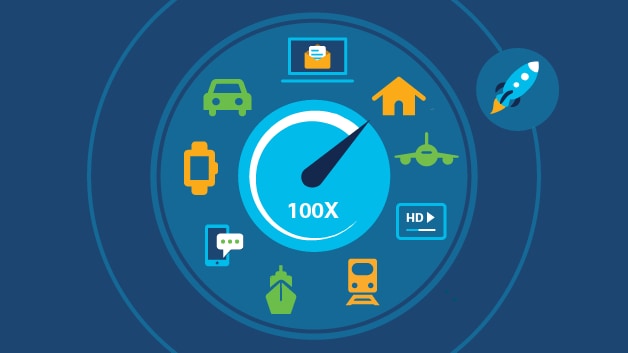What is a 5G network?
5G networks are 3GPP-based cellular systems and an evolution from 4G. Uniquely, 5G can operate across low-, mid-, and high-band spectrums. Earlier generations used low-band spectrum only.
Individual carriers, like Verizon, Vodafone, and KDDI, are building their 5G networks. Many carriers have acquired more than one band of spectrum (i.e. low-band, and high-band) for better coverage with high-speed capabilities.
How much faster is 5G than 4G?
In theory, 5G delivers an average speed of 10 Gbps, which is more than 100 times faster than current 4G technology. Actual average 5G download speeds are currently being measured between 1.4 and 14 times faster than 4G.
We can expect increased speeds as carriers advance their 5G network buildout. Initial 5G service ran on 5G non-standalone (NSA), which rides on the existing 4G network, limiting speeds. 5G standalone (SA) is expected to attain target speeds with the completion of the rest of the network build (transport, core, for example). Available speeds will also depend on the band used for connecting.
- High band offers the fastest speeds but has distance and building penetration challenges.
- Low band is slower but has the best distance and penetration abilities.
- Midband provides a balance of speed and distance.
Where is 5G available?
Commercial 5G networks have been deployed in many countries worldwide. Countries with faster 5G speeds for downloads than the United States currently include Saudi Arabia, South Korea, Australia, Taiwan, Canada, Kuwait, Switzerland, Hong Kong, Germany, the Netherlands, and the United Kingdom. 5G speeds are generally faster in countries like Saudi Arabia and South Korea because of the wider use of midband spectrum by their 5G carriers.
What are 5G speeds for downloads and uploads?
5G download speed is the rate at which data is transmitted from the network to a device. These files may include music, videos, and email. 5G has the potential for download speeds between 10 and 20 Gbps, or 100 times faster than 4G.
5G upload speed is the rate at which data is transmitted from your device up to the network and your targeted endpoint (cloud storage, for example, or another device). Upload speeds are generally much slower than download speeds. However, 5G upload speeds can be up to 30 percent faster than 4G.
What is mmWave?
mmWave is high-band spectrum, and it represents a largely unused portion of the radio frequency spectrum. Also known as millimeter wave or millimeter band, mmWave has wavelengths between 24 GHz and 100 GHz.
Millimeter wave bands offer the fastest data rates, but their coverage distance is limited. Buildings, trees, and other large objects can also block these bands. mmWave technology can be deployed along with lower-band radio to provide a balanced service of speed and coverage.
It's expected that mmWave will help support massive Internet of Things (IoT) applications in the future.
